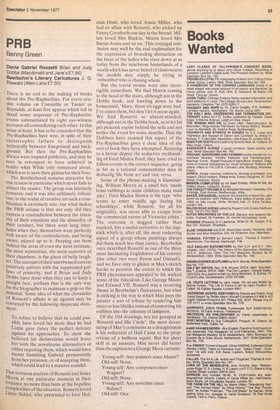PRB
Benny Green
Dante Gabriel Rossetti Brian and Judy Dobbs (Macdonald and Jane's £7.95) Beerbohm's Literary Caricatures J. G. Riewald (Allen Lane £7.50) There is no end to the making of books about the Pre-Raphaelites. For every erudite volume on Constable or Turner or Reynolds, at least five appear which tell in detail some sequence of Pre-Raphaelite events substantiated by eight eye-witness accounts all contradicting each other. In this sense at least, it has to be conceded that the Pre-Raphaelites have won, in spite of their catastrophic failure to distinguish technically between foreground and background. But then the Pre-Raphaelites always were inspired publicists, and may be seen in retrospect to have achieved in reality what Wilde only romanced about, Which was to save their genius for their lives.
The Brotherhood remains attractive for one reason in particular which never fails to attract the reader. The group was intensely romantic and it was also sublimely ridiculous; in the realm of creative art such a combination is extremely rare, hut what makes the PRB unique is that not only did they express a contradiction between the intensity of their emotions and the absurdity of their conduct, but there were long interludes when they themselves were perfectly well aware of the contradiction, and being aware, played up to it. Peeping out from behind the arras of even the most intimate, the most mysterious, the most secretive of their chambers, is the ghost of belly laughter. The account of their intertwined careers Positively quivers with the suppressed guffaws of posterity, and if Brian and Judy Dobbs have done what they can to keep a straight face, perhaps that is the only way for the biographer to maintain a grip on the material. Some idea of what the chronicler of Rossetti's affairs is up against may be Conveyed by the following desperate statement: To refuse to believe that he could possibly have loved her more than he had Lizzie gave Janey the perfect defence against his approaches. To show she believed his declarations would leave her with the unwelcome alternatives of either rejecting them, which would have meant banishing Gabriel permanently • from her presence, or of accepting them, which could lead to a massive scandal.
That tortuous analysis of Rossetti and Janey Morris at one particular moment in their romance no more than hints at the hopeless eTinplexities of the situation. Rossetti loved LIzzie Siddal, who pretended to love Hol man Hunt, who loved Annie Miller, who had an affair with Rossetti, who picked up Fanny Cornforth one day in the Strand. Millais loved Mrs Ruskin, Morris loved Mrs Burne-Jones and so on. This conjugal confusion may well be the real explanation for the expression of brooding distraction on the faces of the ladies who stare down at us today from the tenebrous hinterlands of a world which has never heard of chairoscuro; the models may simply be trying to remember who is chasing whom.
But the torrid swains were also incorrigible comedians. We find Morris coming to the head of the stairs, although not in the Dobbs book, and bawling down to the housemaid, 'Mary, those six eggs were bad. I've eaten them, but don't let it occur again.' We find Rossetti so absent-minded, although not in the Dobbs book, as to let his pet peacock expire behind the sofa and not notice the event for some months. That the Dobbses have resisted this aspect of the Pre-Raphaelites gives a clear idea of the sort of book they have attempted. Resisting to a heroic degree the seductive mythmaking of Ford Madox Ford, they have tried to follow events in the correct sequence, going as far as a rational commentator dare in deducirig life from art-and vice versa.
Sonic of the phrase-making is illuminating. William Morris as a small boy 'made brass rubbings as some children make mud pies'; Ford Madox Brown is the type 'who seems to enter middle age during his schooldays', while Rossetti, 'for all his originality, was never able to escape from the commercial nature of Victorian ethics.' The outcome is dogged rather than inspired, but a useful corrective to the slapstick which is, after all, the most endearing aspect of a group whose paintings always did them much less than justice. Beerbohm once described Rossetti as one of the three most fascinating Englishmen of his century (the other two were Byron and Disraeli), and we have only to glance at Max's sketch books to perceive the extent to which the PRB phenomenon appealed to his wicked sense of the ridiculous. Like George Moore and Edward V11, Rossetti was a recurring theme in Beerbohm's Caricatures, but what is striking is the way in which Max pays the painter a sort of tribute by rendering him more or less lifelike instead of contorting his outlines into the calumny of lampoon.
Of the 104 drawings, ten are grouped as 'Rossetti and His Circle'; the most devastating of Max's comments as a draughtsman is his reduction of Hall Caine to the proportions of a bulbous squirt. But for sheer skill as an assassin, Max never did better than the caption to a George Moor cartoon: Young self: Any painters since Manet? Old self: None.
Young self: Any composers since Wagner?
Old self: None.
Young self: Any novelists since Balzac?
Old self: One.


































 Previous page
Previous page